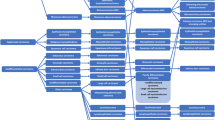Abstract
WHO classification of pituitary adenomas was revised in 2017. The two major and significant changes are discussed. (1) The new classification focuses on adenohypophysial-cell lineage for the designation of adenomas, and thus, assessment of pituitary transcription factors is recommended. Its appropriate use has a complementary role in obtaining an accurate diagnosis, particularly in hormone-negative adenomas. Subclassification of nonfunctioning adenomas was revised accordingly and, consequently, null cell adenomas became quite rare. (2) “Atypical adenoma”, a previous category, was eliminated due to the poor reproducibility and predictive value. Assessment of tumor proliferation marker and other clinical parameters such as invasion are recommended to predict aggressiveness. “High-risk adenomas” are those with rapid growth, radiological invasion, and a high Ki-67 proliferation index, whereas some special adenoma subtypes commonly show aggressive behavior.



Similar content being viewed by others
References
Lopes MBS (2017) The 2017 World Health Organization classification of tumors of the pituitary gland: a summary. Acta Neuropathol 134:521–535
Osamura RY, Lopes MBS, Grossman A, Kontogeorgos G, Trouillas J (2017) Introduction. In: Lloyd RV, Osamura RY, Klöppel G, Rosai J (eds) WHO classification of tumours of endocrine organs, 4th edn. IARC, Lyon, p 13
Osamura RY, Lopes MBS, Grossman A, Matsuno A, Korbonits M, Trouillas J, Kovacs K (2017) Pituitary adenoma. In: Lloyd RV, Osamura RY, Klöppel G, Rosai J (eds) WHO classification of tumours of endocrine organs, 4th edn. IARC, Lyon, pp 14–18
Asa SL (2008) Practical pituitary pathology. What does the pathologists need to know? Arch Pathol Lab Med 132:1231–1240
Mete O, Asa SL (2012) Clinicopathological correlations in pituitary adenomas. Brain Pathol 22:443–453
Nishioka H, Inoshita N, Mete O, Asa SL, Hayashi K, Takeshita A, Fukuhara N, Yamaguchi-Okada M, Takeuchi Y, Yamada S (2015) The complementary role of transcription factors in the accurate diagnosis of clinically nonfunctioning pituitary adenomas. Endocr Pathol 26:349–355
Nishioka H, Inoshita N, Sano T, Fukuhara N, Yamada S (2012) Correlation between histological subtypes and MRI findings in clinically nonfunctioning pituitary adenomas. Endocr Pathol 23:151–156
Scheithauer BW, Jaap AJ, Horvath E, Kovacs K, Lloyd RV, Meyer FB, Laws ER Jr, Young WF Jr (2000) Clinically silent corticotroph tumors of the pituitary gland. Neurosurgery 47:723–730
Erickson D, Scheithauer B, Atkinson J, Horvath E, Kovacs K, Lloyd RV, Young WF Jr (2009) Silent subtype 3 pituitary adenoma: a clinicopathologic analysis of the Mayo clinic experience. Clin Endocrinol 71:92–99
Nishioka H, Kontogeorgos G, Lloyd RV, Lopes BS, Mete O, Nose V (2017) Pituitary gland: null cell adenoma. In: Lloyd RV, Osamura RY, Klöppel G, Rosai J (eds) WHO classification of tumours of endocrine organs, 4th edn. IARC, Lyon, pp 37–38
Balogun JA, Monsalves E, Juraschka K, Parvez K, Kucharczyk W, Mete O, Gentili F, Zadeh G (2015) Null cell adenomas of the pituitary gland: an institutional review of their clinical imaging and behavioral characteristics. Endocr Pathol 261:63–70
Trouillas J, Roy P, Sturm N et al (2013) A new prognostic clinicopathological classification of pituitary adenomas: a multicentric case-control study of 410 patients with 8 years post-operative follow-up. Acta Neuropathol 126:123–135
Kleinschmidt-DeMasters BK (2006) Subtyping does matter in pituitary adenomas. Acta Neuropathol 111:84–85
Asa SL, Casar-Borota O, Chanson P et al (2017) Pituitary adenoma to pituitary neuroendocrine tumor (PitNET): an international pituitary pathology club proposal. Endocr Relat Cancer 24:C5–C8
Author information
Authors and Affiliations
Corresponding author
Rights and permissions
About this article
Cite this article
Nishioka, H., Inoshita, N. New WHO classification of pituitary adenomas (4th edition): assessment of pituitary transcription factors and the prognostic histological factors. Brain Tumor Pathol 35, 57–61 (2018). https://doi.org/10.1007/s10014-017-0307-7
Received:
Accepted:
Published:
Issue Date:
DOI: https://doi.org/10.1007/s10014-017-0307-7




